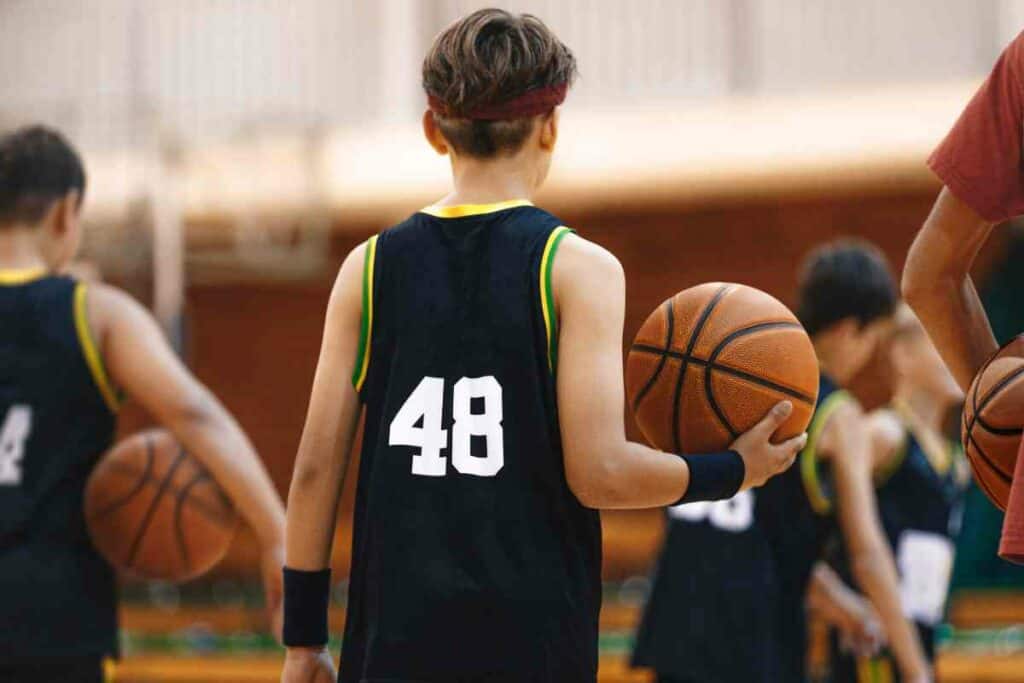How Long Is a Junior High Basketball Game?
Have you ever wondered how long a junior high basketball game lasts? Whether you’re a budding player, a dedicated coach, or a supportive parent, understanding the game’s duration is key. Unlike the longer matches at high school or professional levels, junior high games are tailored to the unique needs of younger athletes, both in terms of development and physical stamina.

Related Post! How Long Are Middle School Basketball Quarters?
How long are middle school basketball games?
A junior high basketball game typically lasts about 24 to 32 minutes, divided into either four quarters of 6 to 8 minutes each or two halves of 12 to 16 minutes. This duration is specifically designed to suit the developmental needs and physical endurance of younger athletes in junior high.
Junior high basketball games are a whirlwind of excitement, typically divided into quarters. The length of these quarters varies, usually falling between 6 to 8 minutes. This shorter format is perfect for keeping the game lively and engaging for our young athletes. It’s not just about playing time; these regulations are crafted to encourage more active participation and learning on the court.
Key Takeaways:
- Junior high games feature shorter quarters, perfect for young athletes.
- The timing rules are designed to boost active play and learning.
- The game’s duration is thoughtfully adapted to the developmental stage of junior high students.
Understanding Junior High Basketball Game Duration
Diving into the specifics, junior high basketball games are a lesson in time management and strategy. The game’s structure, whether it’s divided into halves or quarters, depends on the league’s rules. This setup ensures regular breaks and strategic planning opportunities.

Quarter Lengths
Each quarter zips by, lasting typically 6 to 8 minutes. But remember, the actual time might vary depending on your league or district. The clock pauses for various reasons, like fouls and timeouts, so the game might stretch a bit longer than expected.
Halftime Duration
Halftime is more than just a break; it’s a crucial time for rest and strategy. Lasting about 5 to 10 minutes, it’s a chance for teams to catch their breath and for coaches to share their wisdom.
Overtime Rules
What happens if the score is tied? We head into overtime! Each overtime period in junior high basketball is usually 4 minutes long, but this can change based on league rules. If a tie persists, the game continues with additional overtimes until a winner emerges.
Related Post! How Long Are Junior High Football Games?
Timing Regulations
When you’re part of the junior high basketball scene, getting a grip on the specific timing rules is key to playing your best game or coaching effectively.
Clock Management
In the dynamic world of junior high basketball, game time is neatly packaged into either four quarters or two halves. Each quarter typically spans 6 to 8 minutes, or if played in halves, you’re looking at 12 to 16 minutes each. This setup results in a total playtime of about 24 to 32 minutes – a brisk pace compared to the longer durations in high school, college, or professional basketball.
Timeouts and Delays
Strategic breaks are part of the game’s rhythm. In junior high basketball, teams are allotted a certain number of timeouts, usually lasting from 30 seconds to 1 minute. These timeouts, generally ranging from 3 to 5 per game, offer a quick breather for players and a golden opportunity for coaches to strategize. These pauses are crucial, as they extend the actual game duration beyond the ticking game clock.
Shot Clock Considerations
Here’s a twist: junior high basketball often skips the shot clock, a staple in higher levels like high school and professional games. This absence means there’s no set time limit for a team to attempt a shot. This can influence the game’s tempo and demands savvy clock management skills from the players, balancing the pace without unnecessary delays.
Comparative Lengths Across Divisions

The duration of basketball games varies widely across different levels:
- High School Basketball: Governed by the NFHS, these games typically consist of four 8-minute quarters, totaling 32 minutes. But with stoppages, halftime, and overtimes, the real-time can stretch to about 1.5 hours.
- College Basketball: Under NCAA rules, games are longer, with two 20-minute halves totaling 40 minutes of gameplay. Including various stoppages, a college game can extend close to 2 hours.
- Professional Basketball: In the NBA and WNBA, games are divided into four 12-minute quarters, amounting to 48 minutes of game time. However, with stoppages, halftime, and overtimes, the duration often exceeds 2 hours. FIBA games, meanwhile, play out in four 10-minute quarters, similar to NCAA but totaling 40 minutes.
Impact of Game Length on Players
The duration of a junior high basketball game not only shapes your journey as an athlete but also plays a crucial role in your physical health and safety.
Skill Development and Experience
Playing basketball games of the right length is a boon for your skill development and experience. Regular participation in games with adequate duration allows you to:
- Apply learned skills in diverse competitive scenarios.
- Gain invaluable in-game experience, crucial for understanding situations and making smart decisions.
This balance between skill practice and actual gameplay is essential for your all-around growth as a player. More time on the court during games means more chances to hone your techniques, grasp team dynamics, and delve into the strategic aspects of basketball.
Athlete Health and Safety
Your health and safety are of utmost importance, and the length of basketball games is a significant factor here. While excessive game time can lead to injuries and burnout, an appropriate game length ensures:
- Injury Prevention: Adequate breaks and a game duration suited to your age group help minimize overuse injuries.
- Physical Health: It ensures a gradual build-up of cardiovascular and muscular endurance, reducing the risk of physical strain.
- Wellness: Shorter game durations for junior high athletes promote a healthy balance between competitive play, skill development, and overall well-being, helping to prevent burnout.
Careful consideration of game duration is key to keeping your passion for the sport alive while protecting you from potential health risks.
Game Flow and Strategy
In junior high basketball, mastering game flow and strategy is vital for both coaches and players. This involves timely decisions on substitutions and timeouts, and effective execution of defensive and offensive plays.
Substitutions and Timeouts
- Substitutions are a strategic tool for managing player fatigue and leveraging matchups. Players are often rotated based on stamina, performance, and game pace. High-tempo games may require more frequent substitutions to maintain energy levels.
- Timeouts are pivotal in changing the game’s momentum. A full timeout, typically lasting one minute, is used for strategizing or disrupting the opponent’s rhythm. Media timeouts, which occur at set times in broadcasted games, offer longer breaks for rest and tactical discussions.
Defensive and Offensive Plays
- Defensive Strategies: Coaches often alternate between man-to-man and zone defenses to challenge the opposing team’s offense. Success here depends on players’ quick adaptation and anticipation of the opponents’ moves.
- Offensive Strategies: Implementing structured plays is key to creating scoring opportunities. These plays should align with your team’s strengths and target the defense’s vulnerabilities, ranging from simple pass-and-move tactics to intricate set plays.
Remember:
- Substitutions and timeouts are strategic tools.
- Defensive plays require adaptability and anticipation.
- Offensive plays should capitalize on team strengths.
Infamous Extremes in Basketball Game Lengths
Exploring the extremes of basketball game durations, two notable NBA instances stand out:
- Longest NBA Game: On January 6, 1951, the Indianapolis Olympians and the Rochester Royals played the longest NBA game, lasting 78 minutes, including six overtimes.
- Memorable Playoff Extended Games: Playoff games can stretch longer due to their intensity. For example, in 2019, the Portland Trail Blazers and the Denver Nuggets played for 68 minutes, one of the longest recent playoff games.
These instances, while far beyond the typical 32-minute junior high basketball game, highlight the endurance and resilience of professional athletes in basketball history.
Frequently Asked Questions
Understanding the structure of junior high basketball games helps you appreciate the game and manage your time when attending one.
What is the typical duration of a junior high school basketball match?
The typical duration of a junior high basketball game is around 1 to 1.5 hours, including time for breaks and timeouts.
How many quarters are there in a junior high basketball game, and how long is each?
A junior high basketball game usually consists of four quarters, each lasting about 6 to 8 minutes.
What is the total number of minutes played in a junior high basketball game?
You can expect the total minutes of play in a junior high basketball game to range from 24 to 32 minutes of actual game time.
How many timeouts are teams allowed during a junior high basketball game?
During a junior high basketball game, teams are typically allowed three to five timeouts for the entire match to strategize and rest.
Does the length of a junior high basketball game vary by state or region?
Yes, the length of a game can vary by state or region, with some places opting for shorter or longer playing times or quarters.
What are the common time allowances for breaks and halftime in junior high basketball?
Breaks between quarters are usually around 1 to 2 minutes, and the halftime break may last 5 to 10 minutes.
